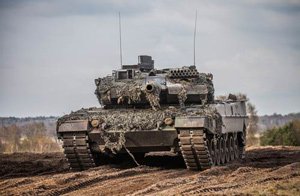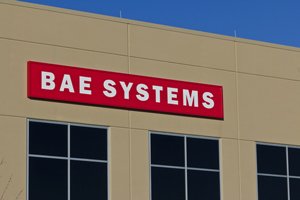We've talked about some truly revolutionary tech developments rocking the entire defense sector right now, like laser weapons, advanced drones, fifth-generation bombers and fighter aircraft, battlefield AI, and global awareness.
It all sounds very sci-fi, but it's happening now (and making us some serious money).
I want to talk about something a little less flashy but perhaps even more important to keeping our armed forces effective when boots are on the ground.
It's not headline-grabbing, and you certainly couldn't call it "state of the art." In fact, at less than $5 billion, it's a relatively small, overlooked niche in one of the world's most lucrative, high-profile sectors.
That's just one of the reasons why I love it right now. The upside is huge, market-crushing, and it's all likely headed to this European company with a U.S. presence...
Big Changes Are Coming to Europe
The world has changed over the past eight months. Defense spending is coming out from under the onerous "sequestration" limits that kept it tightly capped for years.
What's more, U.S. President Donald Trump has put America's European Union (EU) and NATO allies on notice that they will have to beef up their defense spending to meet the treaty's "2% obligation," even if he's mistaken about precisely why they must do so.
That's going to have some unintended knock-on effects, and this is exactly the right time to get in front of them.
 You see, historically, much of Western Europe's defense spending ends up here in the United States, with our defense contractors. This was done largely because NATO was content to let the United States take a leading role in collective defense. There are European defense firms, of course, but mostly they're absolutely dwarfed by the likes of Lockheed Martin Corp. (NYSE: LMT), say, or Northrop Grumman Corp. (NYSE: NOC), or Boeing Co. (NYSE: BA).
You see, historically, much of Western Europe's defense spending ends up here in the United States, with our defense contractors. This was done largely because NATO was content to let the United States take a leading role in collective defense. There are European defense firms, of course, but mostly they're absolutely dwarfed by the likes of Lockheed Martin Corp. (NYSE: LMT), say, or Northrop Grumman Corp. (NYSE: NOC), or Boeing Co. (NYSE: BA).
Now, NATO has seen some changes in its 68-year history. The end of the Cold War, for instance, opened up the alliance to several former Warsaw Pact adversaries, and the Sept. 11, 2001, attacks on New York and Washington, D.C., "refocused" the organization on security concerns like global terrorism.
The new administration in Washington means change is coming again. The Europeans see they might not be able to take a leading U.S. role for granted any more, and there's quiet acknowledgement that defense spending in the alliance will have to increase in the face of Vladimir Putin's resurgent, ambitious Russia.
The plan is now for NATO and the EU's member states to develop a more robust, "homegrown" pan-European defense posture, with European defense contractors set to reap the most business.
Up till now, each country has built up a national defense force, by and large, with their own equipment.
Just last month the head of the European Union noted that while the United States has one main battle tank for its armed forces, Europe has 17. Wheeled and tracked vehicles are absolutely critical to fielding armies, getting them where they need to be, and keeping them supplied.
Harmonizing and rationalizing these vehicles among Europe's allied militaries means big opportunities for military contractors with the capacity and technical knowledge to provide said vehicles for the future European defense force.
Unfortunately for U.S. contractors, most European countries are more interested in building up their own countries' defense firms than handing the builds and maintenance contracts over to American firms.
[mmpazkzone name="in-story" network="9794" site="307044" id="137008" type="4"]
Now, don't worry for a second about our plays in the American defense sector. It's not going anywhere, and the growth potential here on U.S. military spending is staggering. What's more, we're in the middle of a broader trend where U.S. contractors are picking up dollars spent by non-European allies, like Australia and Japan.
Nevertheless, I think there's going to be one really big winner in this pan-European defense effort.
Boost Your Profit Potential with the "Best of British"
 I really love BAE Systems Plc.'s (OTCMKTS ADR: BAESY) position in this space. It's the United Kingdom's biggest defense contractor and the third-biggest worldwide, based on 2015 revenue.
I really love BAE Systems Plc.'s (OTCMKTS ADR: BAESY) position in this space. It's the United Kingdom's biggest defense contractor and the third-biggest worldwide, based on 2015 revenue.
BAE is the successor company to legendary British aviation and shipbuilding firms that helped win the First and Second World Wars. BAE's "heritage" includes Supermarine Aviation, whose Spitfire fighter ruled the skies during the Battle of Britain. Yarrow Shipbuilders built the Royal Navy's first-ever destroyers, and Vickers gave the "Senior Service" its first-ever combat submarines.
On the civilian side, De Havilland Aircraft Co. built the world's first commercial jet, the Comet, and British Aircraft Corp. built the world's first supersonic commercial aircraft, Concorde.
These days, BAE is a globally focused operation that's only improved on its impressive forbears' groundbreaking work.
In an interesting twist, this British contractor even supplies the U.S. military, providing the perfect template for European military forces looking to "simplify." In July 2016, the U.S. Army released its top 10 wish list of projects it hopes to get on the books in coming budget cycles.
Some are relatively small but important items like new hand grenades or better tourniquets, but a significant number are about armored vehicles and mobile artillery.
That's right in BAE's wheelhouse.
In 2005, BAE bought the company that built the Bradley Armored Multi-Purpose Vehicle (AMPV). The Bradley has been a workhorse for moving Army troops since then. After years of service, it's now getting rebuilt from top to bottom - a $300 million buildout.
When the U.S. Army needed firepower and mobility, BAE came in with the Stryker Dragoon, a contract worth $666 million.
On the heavy mobile artillery side, there's BAE's M109 "Paladin" 155 mm Howitzer. In one form or another, the Paladin has been the Army's go-to mobile cannon since the 1960s.
Over the years, there have been a number of programs to replace Paladin but nothing seemed to work as well. Now there's Paladin Integrated Management (PIM) underway to upgrade parts, subsystems, and equipment, as well as companion Field Artillery Ammunition Service Vehicles (FAASV). Price tag: $636 million.
That's $1.2 billion in new business, just in the United States and just in the next year. BAE can and will sell these systems all over the world, especially to the more than 29 European allies looking to operate on consistent, harmonized platforms.
The Market Hasn't Priced in This Growth Potential
While BAE is up 15% year to date and is still throwing off a juicy 3.1% dividend yield, much of that progress doesn't include these big European and U.S. projects because the budget process isn't official yet.
But the fact is, when the economy is sluggish and politicians' popularity is mediocre or worse, there's nothing better than defense spending to perk things up.
It's an easy sell, and the defense sector is a massive employer. Most firms have strategically built out their operations so there are large clusters of employees scattered across many jurisdictions.
The logic is when times get tough, if you cut defense, you lose workers, and no politician, even in Europe, wants to face reelection after a major employer has left town.
But beyond the pragmatic, the simple fact is an independent British military contractor is much more appealing to Europe, the Middle East, Asia, and other emerging markets than a U.S. contractor at this point. India will likely be a big client moving forward, as well.
BAE is perfectly situated to become an even bigger global military player in coming years with its ability to work domestically and abroad with equal and unrivaled ease. It won't be long before the market realizes this, at which point its current $32.58 entry price will be a distant memory.
Recommendation: Strong Buy.
Michael has spent more than 34 years covering the defense and technology sector as profits have exploded. Now he thinks the legal cannabis sector could be about to match or beat that performance. Why? Michael says, “I see the exact same forces, like relentless innovation, for one, that made Silicon Valley great hard at work in the emerging marijuana market today. It’s one of the most exciting and potentially lucrative stories I’ve ever covered.” In fact, Michael has researched a kind of “weed investors’ bible” of more than 30 of the best legal marijuana plays on the market today. He’s making sure all of his paid-up Nova-X Report readers get a copy; you can click here to learn how to get yours.
Follow Michael on Facebook and Twitter.
About the Author
Michael A. Robinson is a 36-year Silicon Valley veteran and one of the top tech and biotech financial analysts working today. That's because, as a consultant, senior adviser, and board member for Silicon Valley venture capital firms, Michael enjoys privileged access to pioneering CEOs, scientists, and high-profile players. And he brings this entire world of Silicon Valley "insiders" right to you...
- He was one of five people involved in early meetings for the $160 billion "cloud" computing phenomenon.
- He was there as Lee Iacocca and Roger Smith, the CEOs of Chrysler and GM, led the robotics revolution that saved the U.S. automotive industry.
- As cyber-security was becoming a focus of national security, Michael was with Dave DeWalt, the CEO of McAfee, right before Intel acquired his company for $7.8 billion.
This all means the entire world is constantly seeking Michael's insight.
In addition to being a regular guest and panelist on CNBC and Fox Business, he is also a Pulitzer Prize-nominated writer and reporter. His first book Overdrawn: The Bailout of American Savings warned people about the coming financial collapse - years before the word "bailout" became a household word.
Silicon Valley defense publications vie for his analysis. He's worked for Defense Media Network and Signal Magazine, as well as The New York Times, American Enterprise, and The Wall Street Journal.
And even with decades of experience, Michael believes there has never been a moment in time quite like this.
Right now, medical breakthroughs that once took years to develop are moving at a record speed. And that means we are going to see highly lucrative biotech investment opportunities come in fast and furious.
To help you navigate the historic opportunity in biotech, Michael launched the Bio-Tech Profit Alliance.
His other publications include: Strategic Tech Investor, The Nova-X Report, Bio-Technology Profit Alliance and Nexus-9 Network.



